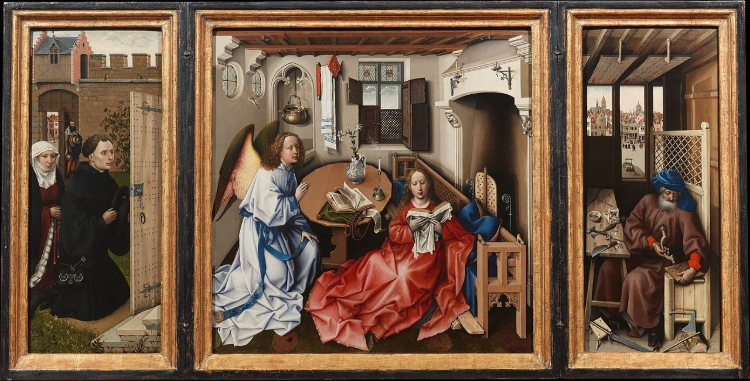The Mérode Altarpiece by the Workshop of Robert Campin

The Mérode Altarpiece by the Workshop of Robert Campin
Oh, hello, angel who's interrupting me while I'm reading a book! I see that you're accompanied by a tiny homunculus floating on a cross.
These obviously must've been the first words out of Mary's mouth as soon as she noticed Gabriel standing across from her.
The artwork is laden with religious symbolism and is a crossover of early Northern Renaissance style and older Medieval techniques. Read on...
Photo bombing - Renaissance style!
The left panel of the triptych (it's not actually a triptych, as the left and right panels were added at the behest of the patron after purchasing the middle panel ) shows representations of the patron and his wife praying in front of the Virgin's domicile. It wasn't uncommon to include representations of patrons in works, since they were shelling out the big coin.
Also, is it just me, or does the patron resemble Andrew Lincoln? In addition to being a zombie hunter, creepy stalker, and ovarian-named angsty 20-something, is he also a time traveler?
I'm going to hit you with this metaphor brick
From the tiny baby Jesus riding a cross on a beam of light, to the walled garden serving as the setting and representing Mary's purity, there's no lack of symbolism in any of the panels.
Joseph's construction of mousetraps in the right panel is a reference to St. Augustine's statement that it is "the devil's mousetrap." In addition to mousetraps, Joseph is actively working on a paddle similar to one used in the Passion before Jesus was crucified.
Because this was intended to be a private piece, it's essentially the 15th-century equivalent of must-see television: pack enough detail into it, so the patrons discover something new on every viewing.
Oil vs. egg
No, we're not making mayonnaise, we're discussing the use of oil paints in northern Europe vs. tempera (egg-based) paint in southern Europe.
Oil paints allowed the artist greater control, so they could add minute details and texture to surfaces. Though the composition still followed medieval conventions - perspective is skewed or non-existent, and figures' features remain simplistic forms - the attention to detail that marked the Renaissance in general is present. Shadows are more realistic, light glitters off surfaces, and decorative elements in the background are still inscribed with minute detail.
